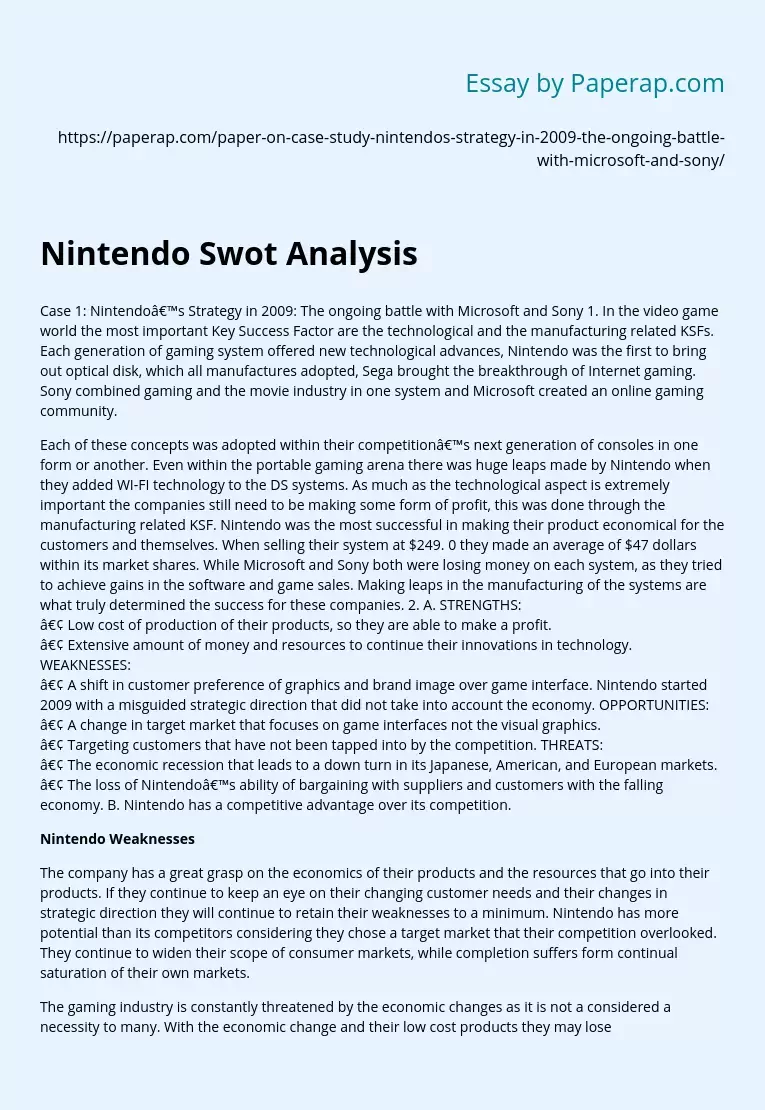Nintendo Swot Analysis
Case 1: Nintendo’s Strategy in 2009: The ongoing battle with Microsoft and Sony 1. In the video game world the most important Key Success Factor are the technological and the manufacturing related KSFs. Each generation of gaming system offered new technological advances, Nintendo was the first to bring out optical disk, which all manufactures adopted, Sega brought the breakthrough of Internet gaming. Sony combined gaming and the movie industry in one system and Microsoft created an online gaming community.
Each of these concepts was adopted within their competition’s next generation of consoles in one form or another.
Even within the portable gaming arena there was huge leaps made by Nintendo when they added WI-FI technology to the DS systems. As much as the technological aspect is extremely important the companies still need to be making some form of profit, this was done through the manufacturing related KSF. Nintendo was the most successful in making their product economical for the customers and themselves.
When selling their system at $249. 0 they made an average of $47 dollars within its market shares. While Microsoft and Sony both were losing money on each system, as they tried to achieve gains in the software and game sales. Making leaps in the manufacturing of the systems are what truly determined the success for these companies. 2. A. STRENGTHS:
• Low cost of production of their products, so they are able to make a profit.
• Extensive amount of money and resources to continue their innovations in technology. WEAKNESSES:
• A shift in customer preference of graphics and brand image over game interface.
Nintendo started 2009 with a misguided strategic direction that did not take into account the economy. OPPORTUNITIES:
• A change in target market that focuses on game interfaces not the visual graphics.
• Targeting customers that have not been tapped into by the competition. THREATS:
• The economic recession that leads to a down turn in its Japanese, American, and European markets.
• The loss of Nintendo’s ability of bargaining with suppliers and customers with the falling economy. B. Nintendo has a competitive advantage over its competition.
Nintendo Weaknesses
The company has a great grasp on the economics of their products and the resources that go into their products. If they continue to keep an eye on their changing customer needs and their changes in strategic direction they will continue to retain their weaknesses to a minimum. Nintendo has more potential than its competitors considering they chose a target market that their competition overlooked. They continue to widen their scope of consumer markets, while completion suffers form continual saturation of their own markets.
The gaming industry is constantly threatened by the economic changes as it is not a considered a necessity to many. With the economic change and their low cost products they may lose their bargaining power and suffer losses placing them behind their competition. Nintendo recognizing this concept shifts its strategic plan to continue to offer its customer’s the gaming experience that consumers would feel displaced if they missed. Based on the SWOT analysis this company has a great standing in its competitive advantages and they are sustainable for the future of the company.
Nintendo Swot Analysis. (2019, Dec 05). Retrieved from https://paperap.com/paper-on-case-study-nintendos-strategy-in-2009-the-ongoing-battle-with-microsoft-and-sony/

